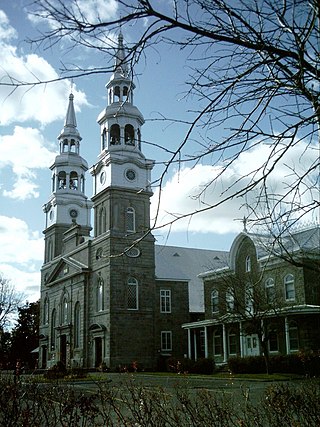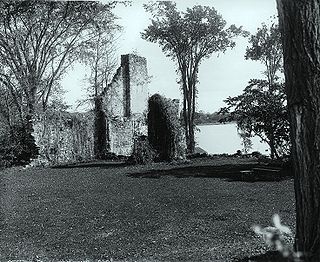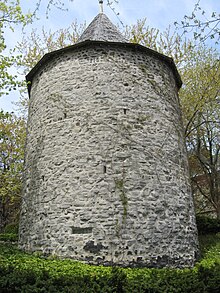The Oka Crisis, also known as the Kanehsatà:ke Resistance ,, or Mohawk Crisis, was a land dispute between a group of Mohawk people and the town of Oka, Quebec, Canada, over plans to build a golf course on land known as "The Pines" which included an indigenous burial ground. The crisis began on July 11, 1990, and lasted 78 days until September 26, with two fatalities. The dispute was the first well-publicized violent conflict between First Nations and provincial governments in the late 20th century.

This section of the Timeline of Quebec history concerns the events between the foundation of Quebec and establishment of the Sovereign Council.

Kanesatake is a Mohawk settlement on the shore of the Lake of Two Mountains in southwestern Quebec, Canada, at the confluence of the Ottawa and Saint Lawrence rivers and about 48 kilometres (30 mi) west of Montreal. People who reside in Kanehsatà:ke are referred to as Mohawks of Kanesatake. As of 2022, the total registered population was 2,751, with a total of about 1,364 persons living on the territory. Both they and the Mohawk of Kahnawake, Quebec, a reserve located south of the river from Montreal, also control and have hunting and fishing rights to Doncaster 17 Indian Reserve.
The Society of Priests of Saint-Sulpice, also known as the Sulpicians, is a society of apostolic life of Pontifical Right for men, named after the Church of Saint-Sulpice, Paris, where it was founded. The members of the Society add the nominal letters PSS after their names to indicate membership in the Congregation. Typically, priests become members of the Society of the Priests of St. Sulpice only after ordination and some years of pastoral work. The purpose of the society is mainly the education of priests and to some extent parish work. As their main role is the education of those preparing to become priests, Sulpicians place great emphasis on the academic and spiritual formation of their own members, who commit themselves to undergoing lifelong development in these areas. The Society is divided into three provinces, operating in various countries: the Province of France, Canada, and the United States.

Oka is a small village on the northern bank of the Ottawa River, northwest of Montreal, Quebec, Canada. Located in the Laurentians valley on Lake of Two Mountains, where the Ottawa has its confluence with the St. Lawrence River, the town is connected via Quebec Route 344. It is located 50 km west of Montreal.

Ignace Bourget was a Canadian Roman Catholic priest who held the title of Bishop of Montreal from 1840 to 1876. Born in Lévis, Quebec, in 1799, Bourget entered the clergy at an early age, undertook several courses of religious study, and in 1837 was named co-adjutor bishop of the newly created bishopric of Montreal. Following the death of Jean-Jacques Lartigue in 1840, Bourget became Bishop of Montreal.

Ahuntsic-Cartierville is a borough (arrondissement) of the city of Montreal, Quebec, Canada. The borough was created following the 2002 municipal reorganization of Montreal. It comprises two main neighbourhoods, Ahuntsic, a former village annexed to Montreal in 1910 and Cartierville, a town annexed to Montreal in 1916.

The Saint-Sulpice Seminary is a building in Montreal, Quebec, Canada. It is the second oldest structure in Montreal and was declared a National Historic Site of Canada in 1980. It is located in the Ville-Marie Borough in the Old Montreal district, next to Notre-Dame Basilica on Notre-Dame Street, facing Place d'Armes. The seminary is a classic U-shaped building featuring a palatial style and includes an annex.

Sault-au-Récollet is a neighbourhood in Montreal. It is located in the eastern edge of the borough of Ahuntsic-Cartierville, bordering the Rivière des Prairies. Autoroute 19 connects Sault-au-Récollet to Laval. The neighbourhood was designated as a heritage site by the City of Montreal in 1992. The Church of the Visitation at Sault-au-Récollet is the oldest church on the Island of Montreal and was built between 1749 and 1752. The streetcar suburb was annexed by Montreal to from the former borough of Ahuntsic-Bordeaux in 1918. A housing boom, mostly made up of multiplexes, followed in the 1940s and 1950s.
Joseph-Alexandre Baile was a Sulpician priest and administrator of seminaries in Montreal. Baile was often in conflict with Joseph-Vincent Quiblier, the superior of the Sulpicians in Canada. He also opposed splitting the Notre-Dame parish of Montreal, and verbally fought with Ignace Bourget about that issue to such an extent that Catholic officials in Rome ended up having to settle the matter themselves by decree. Baile was also a spiritual guide for the Grey Nuns, and helped establish a new seminary in the town of Oka. He retired in 1881 and died in Montreal.
François Picquet was a French Sulpician priest who emigrated to Montreal, Canada, in 1734.

The Fort de La Présentation, a mission fort, was built in 1749 and so named by the French Sulpician priest, Abbé Picquet. It was also sometimes known as Fort La Galette. It was built at the confluence of the Oswegatchie River and the St Lawrence River in present-day New York. The French wanted to strengthen their alliance with the powerful Iroquois, as well as convert them to Catholicism. With increasing tensions with Great Britain, they were concerned about their thinly populated Canadian colony. By 1755 the settlement included 3,000 Iroquois residents loyal to France, in part because of the fur trade, as well as their hostility to encroachment by British colonists in their other territories. By comparison, Montréal had only 4,000 residents.

Fort Senneville is one of the outlying forts of Montreal, Quebec, Canada, built by the Canadiens of New France near the Sainte-Anne-de-Bellevue in 1671. The property was part of a fief ceded to Dugué de Boisbriant in 1672 by the Sulpicians. A large stone windmill, which doubled as a watch tower, was built on a hill by late 1686 and featuring machicolation and other castle-like features. The fort was burned down by Iroquois in 1691, with only the mill itself left standing.

Île de la Visitation is a small island in the Rivière des Prairies, part of the Hochelaga Archipelago, and part of the city of Montreal in Quebec, Canada.

Jean-André Cuoq (1821–1898) was a Roman Catholic priest and a philologist in the Algonquin and Mohawk languages.

The Grand séminaire de Montréal is the centre for priestly formation of the Roman Catholic Archdiocese of Montreal.

Saint-Joseph-du-Lac is a municipality in the Laurentides region of Quebec, Canada, part of the Deux-Montagnes Regional County Municipality.
The timeline of Montreal history is a chronology of significant events in the history of Montreal, Canada's second-most populated city, with about 3.5 million residents in 2018, and the fourth-largest French-speaking city in the world.

Fort Ville-Marie was a French fortress and settlement established in May 1642 by a company of French settlers, led by Paul de Chomedey de Maisonneuve, on the Island of Montreal in the Saint Lawrence River at the confluence of the Ottawa River, in what is today the province of Quebec, Canada. Its name is French for "City of Mary", a reference to the Blessed Virgin Mary.















